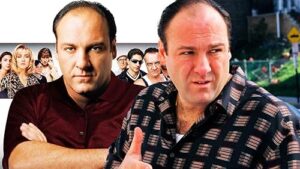
The Family Hour: An Oral History of The Sopranos
Since that controversial last episode of The Sopranos, in June 2007, the cast and crew have never spoken so candidly about the show that changed both their lives and the showbiz landscape. With creator David Chase leading the way, Sam Kashner gets a behind-the-scenes history of a national obsession as James Gandolfini, Edie Falco, Michael Imperioli, and other Sopranos insiders talk about their years as a family, the trauma when someone got whacked , and making their peace with the finale.
There’s a marvelous moment in the second episode of The Sopranos, in which an actor portraying Martin Scorsese is whisked into a nightclub while Christopher Moltisanti, a member of Tony Soprano’s crew, recognizes the famous director and yells out, “Marty! Kundun. I liked it,” referring to the director’s 1997 film about the early life of the Dalai Lama. As a number of the series’s writers told Vanity Fair, a thread of Buddhism runs through several of these 86 tales of murder, betrayal, lust, ambition, and psychotherapy. In Tony’s symbol-laden, near-death dream as he fights for life after being shot in the gut by Uncle Junior, a Buddhist monk gives Tony a Zen-like slap, knocking him to the ground, challenging him to give up his arrogance. But Buddhism isn’t the only surprising element in this saga of a New Jersey crime family; the series creator, David Chase, and his writers were influenced as much by The Honeymooners and The Three Stooges as by Francis Ford Coppola or Martin Scorsese.

The over-the-top violence, for instance, was inspired by the Stooges and also by William Wellman’s The Public Enemy, James Cagney’s 1931 tour-de-force gangster movie, and Cagney himself was a major influence on Chase and many of the writers and actors, such as Tony Sirico, who played Paulie Walnuts with such accuracy that people thought he was a made guy in real life. Tony Soprano (James Gandolfini) is even shown watching the scene of a murdered Cagney, trussed up like a mummy, falling facedown through his mother’s front door. (The depiction of violence on-screen has evolved since 1931, when, incredibly, real bullets were used in The Public Enemy.)
Following its debut, on January 10, 1999, The Sopranos became America’s magnificent obsession. The reviews were so ecstatic that they became the subject of a Saturday Night Live spoof (“The Sopranos is so good, if I had to choose between watching The Sopranos and breathing, I’d pause … think about it … then watch another episode” ). The cast and crew were showered with praise. Journeyman New York actors such as Gandolfini, Edie Falco, Michael Imperioli, and Tony Sirico were suddenly rock stars. Their public appearances at hotels and casinos drew thousands of fans. The show hits every cultural marker: a parody in Mad magazine; the covers of Vanity Fair, Rolling Stone, TV Guide, even The New Yorker; appearances on The Simpsons; not to mention the inevitable academic treatise (“Coming Heavy: Intertextuality and Genre in The Sopranos”). It inspired a pinball machine and a video game (The Sopranos: Road to Respect).
It’s a delicious irony that David Chase—a man devoted to the films of Stanley Kubrick, Scorsese, and Roman Polanski—who had always wanted to direct and write for the movies, scored such a big hit on television. (Chase has finally written and directed his first feature film, Not Fade Away, about a rock band in 1960s New Jersey, starring James Gandolfini and John Magaro, to be released later this year.)
